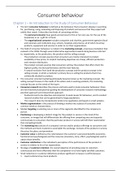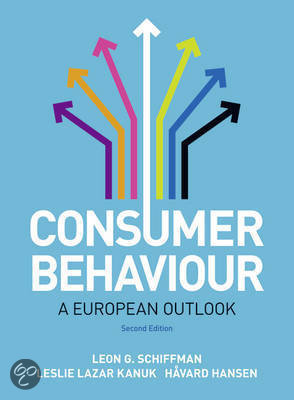Consumer behaviour
Chapter 1 – An Introduction to the Study of Consumer Behaviour
• The term consumer behaviour is defined as the behaviour that consumers display in searching
for, purchasing, using, evaluating and disposing of products and services that they expect will
satisfy their needs. It describes two kinds of consuming entities:
- The personal consumer buys goods and services for this or her own use, for the use of the
household, or as a gift for a friend.
- The organisational consumer includes companies and charities, government agencies (local
and national), and institutions (e.g. schools, hospitals and prisons), all of which must buy
products, equipment and services in order to run their organisations.
• The field of consumer behaviour is rooted in the marketing concept, a business orientation that
evolved in the 1950s through several alternative approaches towards doing business referred
to, respectively, as the production, the product and the selling concept.
- The production concept assumes that consumers are mostly interested in product
availability at low prices; its implicit marketing objectives are cheap, efficient production
and intensive distribution.
- The product concept assumes that consumers will buy the product that offers them the
highest quality, the best performance and the most features.
- A natural evolution from both the production concept and the product concept is the
selling concept, in which a marketer’s primary focus is selling the products that it has
unilaterally decided to produce.
• The consumer-oriented marketing philosophy became known as the marketing concept. The
selling concept focuses on the needs of the sellers and on existing products, the marketing
concept focuses on the needs of the buyer.
• Consumer research describes the process and tools used to study consumer behaviour; there
are two theoretical perspectives guiding the development of consumer research methodology:
positivist approach and interpretivist approach.
- Positivists tend to be objective and empirical, to seek causes for behaviour, and to conduct
research studies that can be generalised to large populations.
- The research done by interpretivists tends to be qualitative and based on small samples.
• Market segmentation is the process of dividing a market into subsets of consumers with
common needs or characteristics.
• Market targeting is selecting one or more of the segments identified for the company to
pursue.
• Positioning is developing a distinct image for the product or service in the mind of the
consumer, an image that will differentiate the offering from competing ones and squarely
communicate to consumers that the particular product or service will fulfil their needs better
than competing brands.
• The marketing mix consists of a company’s service and/or product offerings to consumers and
the methods and tools it selects to accomplish the exchange. Consists of the product or service;
the price; the place; and promotion.
• Customer value is defined as the ratio between the customer’s perceived benefits (economic,
functional and psychological) and the resources (monetary, time, effort, psychological) used to
obtain those benefits.
• Customer satisfaction is the individual’s perception of the performance of the product or
service in relation to his or her expectations.
• Strategy of customer retention: the overall objective of providing value to customers
continuously and more effectively than the competition is to have highly satisfied customers.
• Small reductions in customer defections produce significant increases in profits because:
1. Loyal customers buy more products.
, 2. Loyal customers are less price sensitive and pay less attention to competitors’ advertising.
3. Servicing existing customers is cheaper.
4. Loyal customers spread positive word-of-mouth and refer other customers.
• Classifying customers using a ‘customer pyramid’:
1. The platinum tier includes heavy users who are not price sensitive and who are willing to
try new offerings.
2. The gold tier consists of customers who are heavy users but not as profitable because they
are more sensitive than those in the higher tier, ask for more discounts and are likely to buy
from several providers.
3. The iron tier consists of customers whose spending volume and profitability do not merit
special treatment from the company.
4. The lead tier includes customers who actually cost the company money because they claim
more attention than is merited by their spending, tie up company resources and spread
negative word-of-mouth.
• The societal marketing concept requires that all markets adhere to principles of social
responsibility in the marketing of their goods and services: that is, they should endeavour to
satisfy the needs and wants of their target markets in ways that preserve and enhance the well-
being of consumers and society as a whole.
• Marketing ethics and social responsibility are important components of organisational
effectiveness, resulting not only in a favourable image, but ultimately in increased sales.
• The factors family, friends, advertisers, role models, moods, situation and emotion combined
form a comprehensive model of consumer behaviour that reflects both the cognitive and
emotional aspects of consumer decision-making; three stages:
1. The input stage influences the consumer’s recognition of a product need and consists of
two major sources of information: the firm’s marketing efforts and the external sociological
influences on the consumer.
2. The process stage of the model focuses on how consumers make decisions.
3. The output stage of the consumer decision-making model consists of two post-decision
activities: purchase behaviour and post-purchase evaluation.
Chapter 2 – Consumer Research
• Motivational research was essentially qualitative in approach, and was widely adopted by
consumer researchers. Consumer researchers today use quantitative research and qualitative
research.
• Quantitative research is descriptive in nature and is used by researchers to understand the
effects of various promotional inputs on the consumers, thus enabling marketers to ‘predict’
consumer behaviour. This research approach is known as positivism, and consumer researchers
primarily concerned with predicting consumer behaviour are known as positivists.
• Qualitative research methods consist of depth interviews, focus groups, metaphor analysis,
collage research and projective techniques. A number of academics from the field of consumer
behaviour have become more interested in the act of consumption rather than in the act of
buying (i.e. decision making). Interest in understanding consumer experiences has led to the
term interpretivism, and the researchers who adopt this paradigm are known as interpretivists.
• The major steps in the consumer research process include:
1. Defining the objectives of the research.
2. Collecting and evaluating secondary data.
3. Designing a primary research study.
4. Collecting primary data.
5. Analysing the data.
6. Preparing a report on the findings.
• The first step in the consumer research process is to define carefully the objectives of the
study. A carefully thought-out statement of objectives helps to define the type and level of
information needed.
, • A search for secondary data generally follows the statement of objectives. Secondary
information is any data originally generated for some purpose other than the present research
objectives. Locating secondary data is called secondary research. Original research performed
by individual researchers or organisations to meet specific objectives is called primary research.
• The customer lifetime value (CLV) can be computed from customer acquisition costs, the
profits generated from individual sales to each customer, the costs of handling customer and
their orders, and the expected duration of the relationship.
• Three basic designs are used in quantitative research:
- Observational research: marketers recognise that the best way to gain an in-depth
understanding of the relationship between people and products is by watching them in the
process of buying and using products.
o Mechanical observation uses a mechanical or electronic device to record customer
behaviour or response to a particular marketing stimulus.
o Marketers also use physiological observation devices that monitor respondents’
patterns of information processing.
- Experimentation: in a laboratory or in the field, such as in a retail outlet. A controlled
experiment ensures that any difference in the outcome is due to different treatment of the
variable under study and not to extraneous factors.
- Survey: questioning people by telephone, by post or online.
o Personal interview surveys most often take place in the home or in retail shopping areas.
o Telephone surveys are also used to collect consumer data; however, evenings and
weekends are often the only times to reach telephone respondents, who tend to be less
responsive, to calls that interrupt dinner, television viewing or general relaxation.
o Postal surveys are conducted by sending questionnaires directly to individuals at their
homes.
• A study is said to have validity if it does, in fact, collect the appropriate data needed to answer
the questions or objectives stated in the first (objectives) stage of the research process.
• A study is said to have reliability if the same questions, asked of a similar sample, produce the
same findings.
• Often a sample is systematically divided in two, and each half is given the same questionnaire
to complete. If the results from each half are similar, the questionnaire is said to have split-half
reliability.
• Questions can be open-ended (requiring answers in the respondent’s own words) or closed-
ended (the respondent merely ticks the appropriate answer from a list of options).
• Researchers often present respondents with a list of products or product attributes for which
they are asked to indicate their relative feelings or evaluations. The instruments most
frequently used to capture this evaluative data are called attitude scales.
- Likert scale: respondents tick the number corresponding to their level of ‘agreement’ or
‘disagreement’ with each of a series of statements that describes the attitude object under
investigation.
- Semantic differential scale: consists of a series of bipolar adjectives (good/bad, hot/cold,
like/dislike) anchored at the ends of an odd-numbered (5- or 7-point scale)continuum.
- Behaviour intention scale: measures the likelihood that consumers will act in a certain way
in the futures.
- Rank-order scales: subjects are asked to rank items in order of preference in terms of some
criterion.
• A depth interview is a lengthy, non-structured interview between a respondent and a highly
trained interviewer, who minimises his or her own participation in the discussion after
establishing the general subject to be discusses.
• A focus group consists of eight to ten respondents who meet with a moderator-analyst for a
group discussion ‘focused’ on a particular product or product category. Respondents are
recruited on the basis of a carefully drawn consumer profile (called a screener questionnaire)
based on specifications defined by marketing management and are usually paid a fee.






